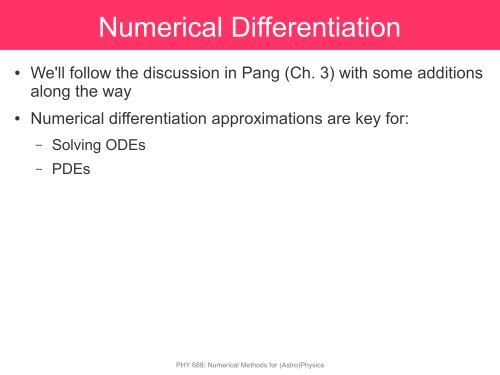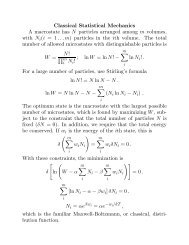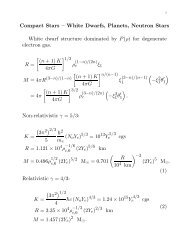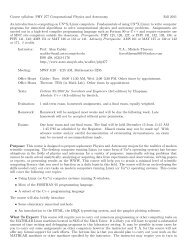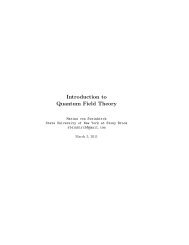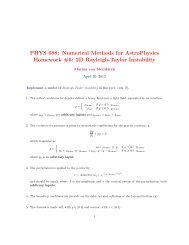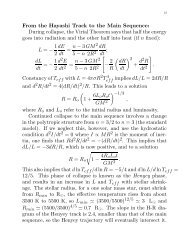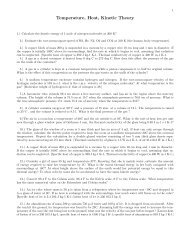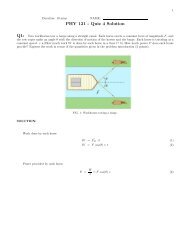Numerical Differentiation
Numerical Differentiation
Numerical Differentiation
Create successful ePaper yourself
Turn your PDF publications into a flip-book with our unique Google optimized e-Paper software.
<strong>Numerical</strong> <strong>Differentiation</strong><br />
●<br />
●<br />
We'll follow the discussion in Pang (Ch. 3) with some additions<br />
along the way<br />
<strong>Numerical</strong> differentiation approximations are key for:<br />
– Solving ODEs<br />
– PDEs<br />
PHY 688: <strong>Numerical</strong> Methods for (Astro)Physics
<strong>Numerical</strong> <strong>Differentiation</strong><br />
●<br />
We can imagine 2 situations<br />
– We have our function f(x) defined only at a set of (possibly<br />
regularly spaced) points<br />
●<br />
Generally speaking, asking for greater accuracy involves using<br />
more of the discrete points in the approximation for f'<br />
– We have an analytic expression for f(x) and want to compute the<br />
derivative numerically<br />
●<br />
●<br />
Usually it would be better to take the analytic derivative of f(x), but<br />
we can learn something about error estimation in this case.<br />
Used, for example, in computing the numerical Jacobian for<br />
integrating a system of ODEs (we'll see this later)<br />
PHY 688: <strong>Numerical</strong> Methods for (Astro)Physics
Gridded Data<br />
●<br />
Discretized data is represented at a finite number of locations<br />
– Integer subscripts are used to denote the position (index) on the<br />
grid<br />
– Structured/regular: spacing is constant<br />
– Data is known only at the grid points:<br />
PHY 688: <strong>Numerical</strong> Methods for (Astro)Physics
First Derivative / Order of Accuracy<br />
●<br />
Taylor expansion:<br />
●<br />
Solving for the first derivative:<br />
Discrete approximation to<br />
Leading term in the<br />
truncation error<br />
PHY 688: <strong>Numerical</strong> Methods for (Astro)Physics
First Derivative / Order of Accuracy<br />
●<br />
●<br />
This is a first-order accurate expression for the derivative at<br />
point i<br />
– Alternately, we can use the point to the left (blackboard)<br />
– The are called difference or finite-difference formulae<br />
Shorthand:<br />
– “big-O notation”<br />
●<br />
How can we get higher order<br />
PHY 688: <strong>Numerical</strong> Methods for (Astro)Physics
First Derivative / Order of Accuracy<br />
●<br />
First derivative approximations:<br />
– First-order (one-sided):<br />
2-point stencil<br />
– Second-order (centered):<br />
3-point stencil<br />
– Fourth-order:<br />
5-point stencil<br />
●<br />
Range of points involved is called the stencil<br />
– Some points may have a '0' coefficient<br />
PHY 688: <strong>Numerical</strong> Methods for (Astro)Physics
First Derivative / Order of Accuracy<br />
●<br />
●<br />
●<br />
General trend: more points = higher accuracy<br />
– Found via Taylor expanding from greater distances and algebra<br />
What happens at the boundaries of our finite-gridded data<br />
– Can interpolate past the last point to use the same stencil<br />
– Can switch to one-sided stencils<br />
Practically speaking: the first and second order approximations<br />
are the ones that are used the most often.<br />
PHY 688: <strong>Numerical</strong> Methods for (Astro)Physics
First Derivative Comparison<br />
analytic: 0.5<br />
left-sided O(dx): 0.639529171481<br />
right-sided O(dx): 0.34028636457<br />
centered O(dx**2): 0.489907768026<br />
centered O(dx**4): 0.499756119208<br />
PHY 688: <strong>Numerical</strong> Methods for (Astro)Physics
Roundoff vs. Truncation Error<br />
(Yakowitz & Szidarovszky)<br />
●<br />
Just evaluating f at our gridded points introduces round-off<br />
error:<br />
– is an approximation to<br />
– Assume some bound:<br />
– Error is (blackboard):<br />
This should be<br />
near machine ε<br />
truncation<br />
roundoff<br />
As ¢ x → ε, the<br />
roundoff term<br />
becomes O(1)<br />
Another thing to consider: with roundoff, is <br />
PHY 688: <strong>Numerical</strong> Methods for (Astro)Physics
Round-off vs. Truncation Error<br />
●<br />
exp(x)<br />
PHY 688: <strong>Numerical</strong> Methods for (Astro)Physics
Higher-Derivatives<br />
●<br />
Graphically<br />
This is 2 nd order at the midpoint between<br />
the two points<br />
This is a centered difference (derivative) of<br />
the derivatives = second derivative<br />
Second-order accurate<br />
●<br />
Also via Taylor expansion (blackboard)<br />
PHY 688: <strong>Numerical</strong> Methods for (Astro)Physics
Non-Uniform Data<br />
●<br />
Two choices:<br />
– Interpolate to a uniform grid<br />
– Re-derive our expressions for a non-uniform grid (preferred)<br />
(blackboard derivation...)<br />
PHY 688: <strong>Numerical</strong> Methods for (Astro)Physics
Analytic f Given<br />
●<br />
●<br />
If we have f(x) available analytically, we can make estimates of<br />
the error<br />
– This will come into play with ODEs, where we have the analytic<br />
righthand side<br />
Controlling accuracy<br />
– Consider:<br />
– We are free to choose h<br />
– Compare to estimate error<br />
PHY 688: <strong>Numerical</strong> Methods for (Astro)Physics
Analytic f Given<br />
●<br />
Iteratively build more accurate approximations<br />
–<br />
– This gives:<br />
– Consider:<br />
– Combine:<br />
– This is an example of Richardson extrapolation—we'll see this<br />
more when we go to ODEs<br />
PHY 688: <strong>Numerical</strong> Methods for (Astro)Physics
<strong>Numerical</strong> Integration<br />
●<br />
We want to solve:<br />
●<br />
●<br />
Again, we have two distinct cases:<br />
– f(x) is provided at discrete points on a grid<br />
– We have an analytic expression for f(x)<br />
We'll follow the discussion in Pang and also that of Garcia<br />
PHY 688: <strong>Numerical</strong> Methods for (Astro)Physics
<strong>Numerical</strong> Integration<br />
●<br />
Simplest case: piecewise constant interpolant (midpoint rule)<br />
PHY 688: <strong>Numerical</strong> Methods for (Astro)Physics
<strong>Numerical</strong> Integration<br />
●<br />
One step up: piecewise linear interpolant (trapezoid rule)<br />
This is just the area<br />
of a trapezoid<br />
PHY 688: <strong>Numerical</strong> Methods for (Astro)Physics
<strong>Numerical</strong> Integration<br />
●<br />
●<br />
As you might expect, the accuracy gets better the higher-order<br />
the interpolating polynomial<br />
– Trapezoid rule will integrate a linear f(x) perfectly<br />
What about a parabola<br />
– For now, we'll stick with equally spaced locations at which we<br />
evaluate f(x)<br />
PHY 688: <strong>Numerical</strong> Methods for (Astro)Physics
Simpson's Rule<br />
●<br />
Piecewise linear interpolant (Simpson's rule)<br />
– 3 unknowns (A, B, C) and 3<br />
points<br />
– Blackboard algrebra...<br />
PHY 688: <strong>Numerical</strong> Methods for (Astro)Physics
Simpson's Rule<br />
●<br />
Then integrate under the parabola<br />
PHY 688: <strong>Numerical</strong> Methods for (Astro)Physics
Summary of Simple Rules<br />
(Yakowitz & Szidarovszky)<br />
●<br />
Error estimates<br />
– Actually rather complicated to derive (see a math text on<br />
<strong>Numerical</strong> Methods)<br />
– Simple trapezoidal:<br />
– Simple Simpson's:<br />
– Note the only way to reduce the error here is to make [a, b]<br />
smaller<br />
– Here, is some unknown point in [a, b]<br />
PHY 688: <strong>Numerical</strong> Methods for (Astro)Physics
Summary of Simple Rules<br />
●<br />
●<br />
Any numerical integration method that represents the integral<br />
as a (weighted) sum at a discrete number of points is called a<br />
quadrature rule<br />
Fixed spacing between points (what we've seen so far):<br />
Newton-Cotes quadrature<br />
PHY 688: <strong>Numerical</strong> Methods for (Astro)Physics
Open Integration Rules<br />
●<br />
Forms of these exist where the end-points of the interval are<br />
not used—these are open integration rules<br />
– Usually not very desirable<br />
– See, for example, <strong>Numerical</strong> Recipes<br />
PHY 688: <strong>Numerical</strong> Methods for (Astro)Physics
Compound Integration<br />
●<br />
●<br />
Mid-point, trapezoidal, and Simpson's integration as we wrote<br />
them are ok when [a,b] is small.<br />
Integrating over large domain is not very accurate<br />
– We could keep adding terms to our polynomials (getting higher<br />
and higher degree), or we could string together our current<br />
expressions<br />
●<br />
More points = more accuracy<br />
– Compound integration—break domain into sub-domains and use<br />
these rules in each sub-domain.<br />
PHY 688: <strong>Numerical</strong> Methods for (Astro)Physics
Compound Integration<br />
● Break interval into chunks<br />
Integral over a<br />
single slab<br />
PHY 688: <strong>Numerical</strong> Methods for (Astro)Physics
Compound Integration<br />
●<br />
Compound Trapezoidal<br />
●<br />
Compound Simpson's<br />
– Integrate pairs of slabs together (requires even number of slabs)<br />
PHY 688: <strong>Numerical</strong> Methods for (Astro)Physics
Compound Integration<br />
Always a good idea to check the convergence rate!<br />
PHY 688: <strong>Numerical</strong> Methods for (Astro)Physics
Adaptive Integration<br />
●<br />
If you know the analytic form of f(x), then you can estimate the<br />
error by increasing N<br />
– Can make use of previous function evaluations (see Garcia)<br />
●<br />
Recover Simpson's rule from adaptive trapezoidal (see NR)<br />
PHY 688: <strong>Numerical</strong> Methods for (Astro)Physics
Gaussian Quadrature<br />
●<br />
Instead of fixed spacing, what if we strategically pick the<br />
spacings<br />
– We want to express<br />
– w's are weights. We will choose the location of points x i<br />
PHY 688: <strong>Numerical</strong> Methods for (Astro)Physics
Gaussian Quadrature<br />
(Garcia, Ch. 10)<br />
●<br />
Gaussian quadrature: fundamental theorem<br />
– q(x) is a polynomial of degree N, such that<br />
– k = 0, ..., N-1 and ρ(x) is a specified weight function.<br />
– Choose x 1<br />
, x 2<br />
, ... x N<br />
as the roots of the polynomial q(x)<br />
– We can write<br />
and there will be a set of w's for which the integral is exact if f(x)<br />
is a polynomial of degree < 2N!<br />
PHY 688: <strong>Numerical</strong> Methods for (Astro)Physics
Gaussian Quadrature<br />
(Garcia, Ch. 10)<br />
●<br />
●<br />
The amazing result of this theorem is that by picking the points<br />
strategically, we are exact for polynomials up to degree 2N-1<br />
– With a fixed grid, of N points, we can fit an N-1 degree<br />
polynomial<br />
●<br />
Exact integration for f(x) only if it is a polynomial of degree N-1 or<br />
less<br />
– If our f(x) is closely approximated by a polynomial of degree 2N-<br />
1, then this will be very accurate.<br />
Many choices of weighting function, ρ(x), leading to different<br />
q's and x's and w's.<br />
PHY 688: <strong>Numerical</strong> Methods for (Astro)Physics
Gaussian Quadrature<br />
(Garcia, Ch. 10)<br />
●<br />
Example from Garcia:<br />
– 3-point quadrature<br />
●<br />
This means 3 roots, so q(x) is a cubic<br />
– Weight function ρ(x) = 1<br />
– Work in the interval [-1, 1]<br />
● Easy to transform from [a, b] to [-1, 1]:<br />
PHY 688: <strong>Numerical</strong> Methods for (Astro)Physics
Gaussian Quadrature<br />
(Garcia, Ch. 10)<br />
●<br />
●<br />
3-point quadrature:<br />
–<br />
Step 1: Apply the theorem to find the c's:<br />
This can give 3 equations for the c's,<br />
allowing us to find q(x) up to some<br />
arbitrary factor.<br />
Alternately, these are the conditions for<br />
the Legendre polynomials (the Gram-<br />
Schmidt orthogonalization)<br />
PHY 688: <strong>Numerical</strong> Methods for (Astro)Physics
Gaussian Quadrature<br />
(Garcia, Ch. 10)<br />
●<br />
Step 2: find the roots (those are our quadrature points)<br />
– For<br />
we can easily factor this:<br />
– This means that our quadrature becomes:<br />
PHY 688: <strong>Numerical</strong> Methods for (Astro)Physics
Gaussian Quadrature<br />
(Garcia, Ch. 10)<br />
●<br />
Step 3: find the weights<br />
– The theorem tells us that with the x's as the roots, then the<br />
proper choice of weights makes the integration exact for<br />
polynomials up to degree 2N-1<br />
this is:<br />
Note the “=”—this is exact<br />
PHY 688: <strong>Numerical</strong> Methods for (Astro)Physics
Gaussian Quadrature<br />
(Garcia, Ch. 10)<br />
– These three equations can be solved to find the weights:<br />
●<br />
Therefore, our 3-point quadrature is:<br />
Our choice of weight function and integration interval results in<br />
the Gauss-Legendre method<br />
PHY 688: <strong>Numerical</strong> Methods for (Astro)Physics
Gaussian Quadrature<br />
● Example:<br />
(Garcia, Ch. 10)<br />
erf(1) (exact): 0.84270079295<br />
3-point trapezoidal: 0.825262955597 -0.017437837353<br />
3-point Simpson's: 0.843102830043 0.000402037093266<br />
3-point Gauss-Legendre: 0.842690018485 -1.0774465204e-05<br />
Notice how well the Gauss-Legendre does for this integral.<br />
PHY 688: <strong>Numerical</strong> Methods for (Astro)Physics
Gaussian Quadrature<br />
●<br />
Other quadratures exist:<br />
(Wikipedia)<br />
●<br />
In practice, the roots and weights are tabulated for these out to<br />
many numbers of points, so there is no need to compute them.<br />
PHY 688: <strong>Numerical</strong> Methods for (Astro)Physics
Multi-dimensional Integration<br />
●<br />
For multi-dimensional integration, Monte Carlo methods may<br />
be faster (less function evaluations)<br />
PHY 688: <strong>Numerical</strong> Methods for (Astro)Physics


